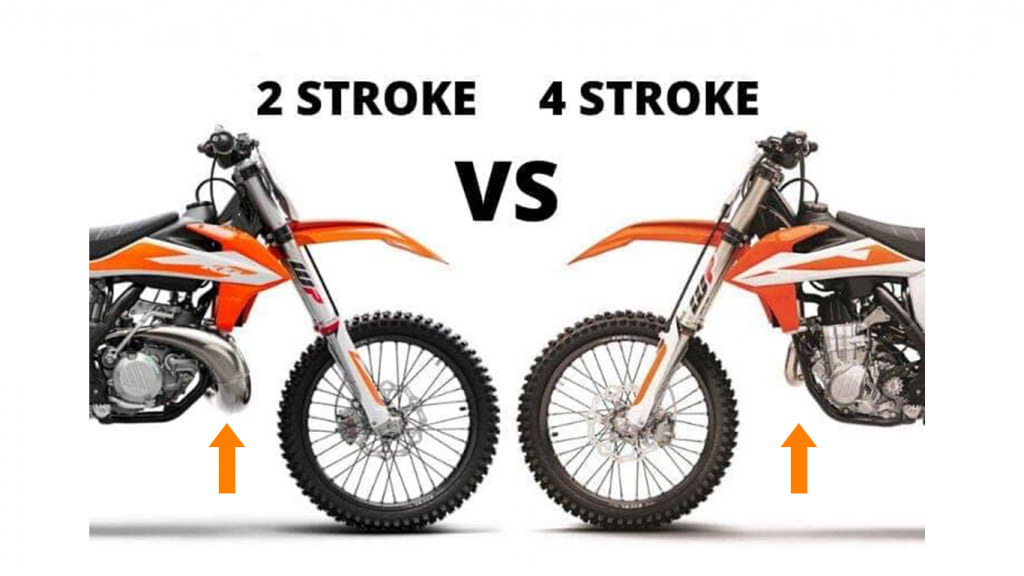The history of motorcycle engines

Steam was the logical first choice of motorcycle engine power. The earliest example is the French Michaux-Perreaux steam velocipede of 1868 (pictured below in all it’s wooden glory). This was followed by the American Roper steam velocipede of 1869, and a number of other steam powered two and three wheelers, manufactured and sold to the public on through the early 20th century.
“Boneshaker” as well as a hilariously accurate name, was a name referring to the first type of true bicycle with pedals. Steam cycles took the frame from this and later the “safety bicycle design” (I’m not sure I’m as trusting of this name), and began experimenting with a variety of engine placement strategies within it, as well as transmission and options.
While today nearly every motorcycle has its engine in the center of the frame; this only became standard around 1900-1910 after nearly every possible engine location was tried.

“The Otto cycle gasoline internal combustion engine” – AKA a modern spark, ignition, piston engine process, was first used on an experimental two-wheeler created by Gottlieb Daimler to test the practicality of such an engine in a vehicle.
This motorcycle, the Daimler Reitwagen, is credited as the world’s first motorcycle by many authorities, partially on the assumption that a motorcycle is defined not as any two-wheel motor vehicle, but a two-wheel internal combustion engine motor vehicle. The Oxford English Dictionary, for example, defines the word motorcycle this way. The steam cycles were also simply neglected and forgotten by many historians, even as the Michaux-Perreaux waited forty years on display in the National Motor Museum, Beaulieu.
In recent years, a surge in interest in clean energy has put many new electric powered two wheelers on the market, and they are registered as motorcycles or scooters, without the type of power being an issue. Diesel motorcycles were also experimented with briefly in the 20th century, and are again the subject of interest due to fuel economy and the needs of military logistics. – I guess steam just didn’t make the moto-cut!
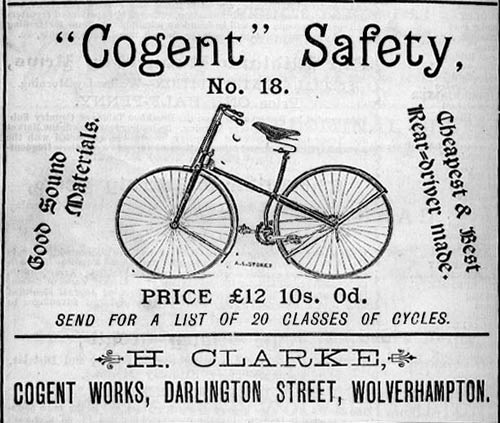
Types of motorcycle engines
Engines are typically 2 stroke or 4 stroke internal combustion engines, but other types such as “Wankels” and “Electric” motors have been used.
Wankel
What the hell is a “Wankel” Engine?
Sounds German right? It is! Felix Wankel from Germany first patented his Wankel engine in 1929. What a marvelous Wank…el that was Felix!
A Wankel engine is still an internal combustion engine but it uses an eccentric rotary design to convert pressure into rotating motion. Unlike our common reciprocating piston engine, which has pistons instantly and rapidly changing direction 180 degrees, the Wankel engines parts rotate in one direction.
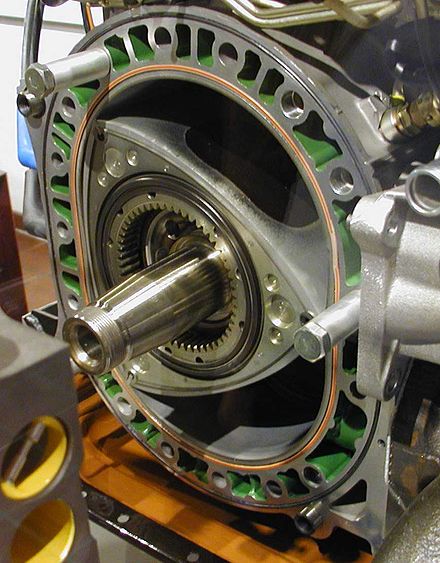
The Wankel engine, in contrast to reciprocating piston designs, delivers advantages of simplicity, smoothness, compactness, high revolutions per minute and a high power to weight ratio.
The core of the Wankel engine is the rotor, which creates the turning motion. It is similar in shape to a Reuleaux triangle with the sides somewhat flatter. Wankel engines deliver three power pulses per revolution of the rotor using the Otto cycle. However the output shaft, because of its toothed gearing to the rotor, turns three times faster giving one power pulse per revolution at its output. The result is that the rotor turns much slower than the output shaft, at one third of its speed.
The rotor in one revolution will be giving power pulses and exhausting simultaneously, while the four stages of the Otto cycle occur at separate times. For comparison, in a two-stroke piston engine there is one power pulse per crankshaft revolution, the same as a Wankel engine’s output shaft, with one in two revolutions in a four-stroke piston engine.
The four-stage Otto cycle of intake, compression, ignition, and exhaust occurs each revolution of the rotor at each of the three rotor faces moving inside the oval-like epitrochoid-shaped housing, enabling the three power pulses per rotor revolution.
Displacement measurement measures only one face of the rotor, since only one face is working for each output shaft revolution.
The engine is commonly referred to as a rotary engine, although this name is also applied to other completely different designs, including both pistoned and pistonless rotary engines.

Schematic of the Wankel:
- Intake
- Exhaust
- Stator Housing
- Chambers
- Pinion
- Rotor
- Crown Gear
- Eccentric Shaft
- Spark Plug
2 Strokes
Formally known as “a whole load of fun” or “Smokers”
A two-stroke (or two-cycle) engine is a type of internal combustion engine which completes a power cycle with two strokes (up and down movements) of the piston during only one crankshaft revolution. This is in contrast to a “four-stroke engine“, which requires four strokes of the piston to complete a power cycle during two crankshaft revolutions. In a two-stroke engine, the end of the combustion stroke and the beginning of the compression stroke happen simultaneously, with the intake and exhaust (or scavenging) functions occurring at the same time.
Two-stroke engines often have a high power-to-weight ratio, power being available in a narrow range of rotational speeds called the “power band”. Compared to four-stroke engines, two-stroke engines less moving parts making them much easier to work on and fix.
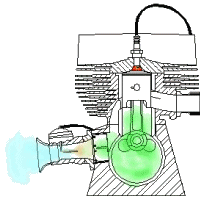
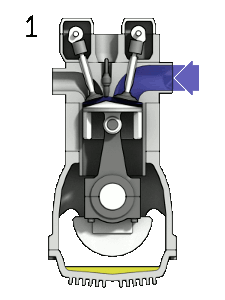
4 Strokes
A 4 stroke engine completes four separate piston strokes while turning the crankshaft. A stroke refers to the full travel of the piston along the cylinder, in either direction. The four separate strokes are termed:
- Intake: Also known as induction or suction. This stroke of the piston begins at top dead center (T.D.C.) and ends at bottom dead center (B.D.C.). In this stroke the intake valve must be in the open position while the piston pulls an air-fuel mixture into the cylinder by producing vacuum pressure into the cylinder through its downward motion. The piston is moving down as air is being sucked in by the downward motion against the piston.
- Compression: This stroke begins at B.D.C, or just at the end of the suction stroke, and ends at T.D.C. In this stroke the piston compresses the air-fuel mixture in preparation for ignition during the power stroke (below). Both the intake and exhaust valves are closed during this stage.
- Combustion: Also known as power or ignition. This is the start of the second revolution of the four stroke cycle. At this point the crankshaft has completed a full 360 degree revolution. While the piston is at T.D.C. (the end of the compression stroke) the compressed air-fuel mixture is ignited by a spark plug (in a gasoline engine) or by heat generated by high compression (diesel engines), forcefully returning the piston to B.D.C. This stroke produces mechanical work from the engine to turn the crankshaft.
- Exhaust: Also known as outlet. During the exhaust stroke, the piston, once again, returns from B.D.C. to T.D.C. while the exhaust valve is open. This action expels the spent air-fuel mixture through the exhaust valve.
These four strokes can be remembered by the colloquial phrase, “Suck, Squeeze, Bang, Blow”.
Identifying the difference between 2 & 4 stroke engines
2 strokes generally arent found in modern street bikes anymore due to their high emissions and need of constant loving and hugging! They are however, found in many off road bikes and classic bikes. 2 stroke engines use a mixture of oil & petrol in a single fuel tank that you manually measure out according to manufacturer ratios and mix together. 4 stroke engines do not require oil and petrol to be mixed and have separate petrol and oil tanks.
2 strokes generally have a “tinny” higher pitched “ring-tin-tin sound to them and the smell of heaven (2 stroke oil) wafting around after them!
You can usually identify a 2 stroke bike visually by its larger expansion chamber. Here’s an example below.
